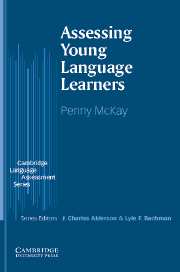Book contents
- Frontmatter
- Contents
- Series editors' preface
- Acknowledgments
- 1 A special case for young learner language assessment
- 2 Young learners and language learning
- 3 Research into the assessment of young language learners
- 4 Assessing language use through tasks
- 5 Classroom assessment of language use
- 6 Assessing oral language
- 7 Assessing reading and writing
- 8 Evaluating young learners' performance and progress
- 9 Testing young language learners through large-scale tests
- 10 The way forward
- References
- Index
- Publishers' acknowledgments
1 - A special case for young learner language assessment
Published online by Cambridge University Press: 04 May 2010
- Frontmatter
- Contents
- Series editors' preface
- Acknowledgments
- 1 A special case for young learner language assessment
- 2 Young learners and language learning
- 3 Research into the assessment of young language learners
- 4 Assessing language use through tasks
- 5 Classroom assessment of language use
- 6 Assessing oral language
- 7 Assessing reading and writing
- 8 Evaluating young learners' performance and progress
- 9 Testing young language learners through large-scale tests
- 10 The way forward
- References
- Index
- Publishers' acknowledgments
Summary
Introduction
This chapter sets out to establish a special case for young learner language assessment. What are the characteristics of young learners that need to be remembered in assessment decisions? We all know that young learners are different from adults, but how do we explain the important differences in a simple, accessible way? This chapter provides some central information about young learners – who they are, where they are learning, and what requires us to give them special consideration in assessment.
Young language learners and their language programmes
Young language learners are those who are learning a foreign or second language and who are doing so during the first six or seven years of formal schooling. In the education systems of most countries, young learners are children who are in primary or elementary school. In terms of age, young learners are between the ages of approximately five and twelve. Many young language learners can be called bilingual. Bilingual learners are those learners who learn two (or more) languages to some level of proficiency (Bialystok, 2001, p. 5). This rather vague definition – impossible to pin down because of the variety of experiences of learners – would tend to include children who are learning a foreign language in immersion and bilingual programmes and all children in second language programmes. The term would also include many, many children who learn a foreign or second language as they interact with speakers of other languages and dialects outside formal language programmes.
- Type
- Chapter
- Information
- Assessing Young Language Learners , pp. 1 - 25Publisher: Cambridge University PressPrint publication year: 2005



